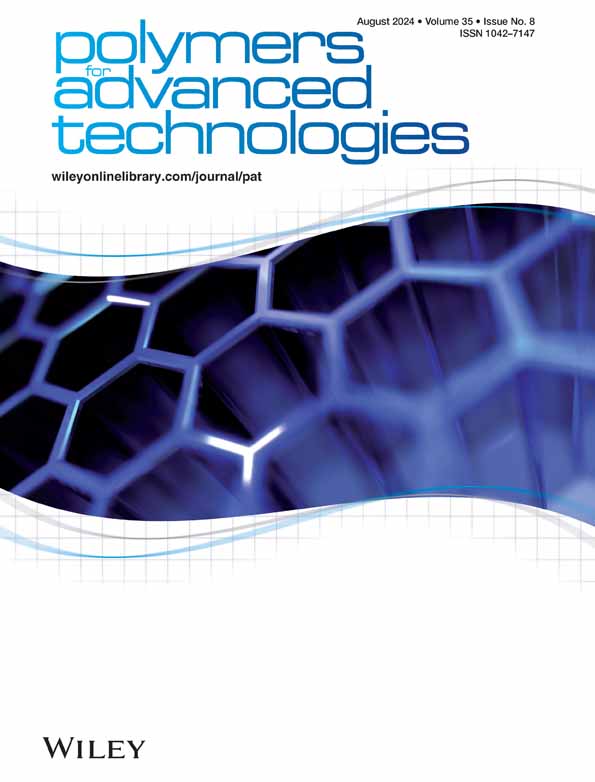Synthesis and rheological analyzes of temperature and light sensitive gels comprising amphiphilic azobenzene polymers, chitosan and pluronic F127
IF 3.4
4区 工程技术
Q2 POLYMER SCIENCE
引用次数: 0
Abstract
This study investigates the reinforcement of pluronic (PF127) based temperature responsive hydrogels with photosensitive functionalities to create smart and injectable materials. For this purpose, 4‐[4‐[(4‐phenyl)azo]phenoxy] methacrylate (PAzPMA) was synthesized and further polymerized via reversible addition‐fragmentation chain transfer (RAFT) polymerization. The structures of the copolymers were characterized by several techniques such as Fourier‐transform infrared (FT‐IR), nuclear magnetic resonance (NMR) spectroscopy and gel permeation chromatography (GPC). The azobenzene‐functionalized copolymer was combined with P127 solid polymer in micelle form and with P127 micelles in solid form to obtain PF127‐AzoMx and PF127‐AzoPx gels, respectively. When the temperature profiles of the PF127‐AzoMx and PF127‐AzoPx systems were compared with PF127, sol–gel phase transition were shifted to lower temperatures due to stronger hydrophobic interactions. Additionally, different concentrations of由两亲性偶氮苯聚合物、壳聚糖和pluronic F127组成的温敏和光敏凝胶的合成与流变分析
本研究探讨了如何用光敏功能增强基于 pluronic(PF127)的温度响应水凝胶,以制造智能注射材料。为此,合成了 4-[4-[(4-苯基)偶氮]苯氧基]甲基丙烯酸酯(PAzPMA),并通过可逆加成-碎片链转移(RAFT)聚合进一步聚合。傅立叶变换红外光谱(FT-IR)、核磁共振光谱(NMR)和凝胶渗透色谱(GPC)等多种技术对共聚物的结构进行了表征。将偶氮苯功能化共聚物与胶束形式的 P127 固体聚合物和固体形式的 P127 胶束结合,分别得到 PF127-AzoMx 和 PF127-AzoPx 凝胶。将 PF127-AzoMx 和 PF127-AzoPx 系统的温度曲线与 PF127 进行比较,发现由于疏水作用更强,溶胶-凝胶相变转移到了更低的温度。此外,还在凝胶体系中添加了不同浓度的 N,N,N-三甲基壳聚糖(f-壳聚糖),并将其置于紫外光下进行流变特性研究。研究发现,f-壳聚糖的存在和浓度对胶束间相互作用强度的变化非常重要。这项研究强调了多功能水凝胶在特定生物医学应用中的潜力,它结合了对热刺激和光刺激的敏感性,可用于控制药物输送和组织工程。
本文章由计算机程序翻译,如有差异,请以英文原文为准。
求助全文
约1分钟内获得全文
求助全文
来源期刊

Polymers for Advanced Technologies
工程技术-高分子科学
CiteScore
6.20
自引率
5.90%
发文量
337
审稿时长
2.1 months
期刊介绍:
Polymers for Advanced Technologies is published in response to recent significant changes in the patterns of materials research and development. Worldwide attention has been focused on the critical importance of materials in the creation of new devices and systems. It is now recognized that materials are often the limiting factor in bringing a new technical concept to fruition and that polymers are often the materials of choice in these demanding applications. A significant portion of the polymer research ongoing in the world is directly or indirectly related to the solution of complex, interdisciplinary problems whose successful resolution is necessary for achievement of broad system objectives.
Polymers for Advanced Technologies is focused to the interest of scientists and engineers from academia and industry who are participating in these new areas of polymer research and development. It is the intent of this journal to impact the polymer related advanced technologies to meet the challenge of the twenty-first century.
Polymers for Advanced Technologies aims at encouraging innovation, invention, imagination and creativity by providing a broad interdisciplinary platform for the presentation of new research and development concepts, theories and results which reflect the changing image and pace of modern polymer science and technology.
Polymers for Advanced Technologies aims at becoming the central organ of the new multi-disciplinary polymer oriented materials science of the highest scientific standards. It will publish original research papers on finished studies; communications limited to five typewritten pages plus three illustrations, containing experimental details; review articles of up to 40 pages; letters to the editor and book reviews. Review articles will normally be published by invitation. The Editor-in-Chief welcomes suggestions for reviews.
 求助内容:
求助内容: 应助结果提醒方式:
应助结果提醒方式:


